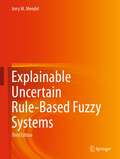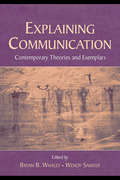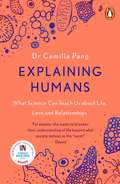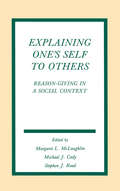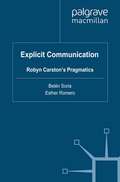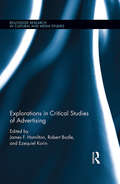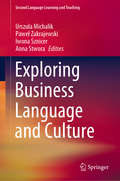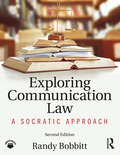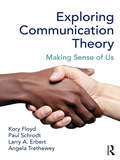- Table View
- List View
Expert Microsoft Teams Solutions: A guide to Teams architecture and integration for advanced end users and administrators
by Aaron Guilmette Yura Lee Grant Oliasani Angel AvilesWritten by Microsoft engineers, Expert Microsoft Teams Solutions covers in-depth topics in Teams that are not covered elsewhere and explores tasks that customers frequently rely on Microsoft Partners to accomplishKey FeaturesExtend the MS Teams experience with this practical guide from Microsoft's technical specialistsDiscover advanced Teams capabilities such as voice, governance, and Power Platform integrationGet to grips with planning resources for voice integration in TeamsBook DescriptionMicrosoft Teams is designed to improve collaboration and integrate components of SharePoint, Exchange, Power Platform, and voice calling into a single platform. Complete with step-by-step explanations of concepts, practical examples, and architecture guidance, you'll learn how to plan and deploy Teams for your organization. As you progress, you'll explore and understand the Teams platform as a whole, from architecture and collaboration through to apps and voice, with the help of examples. The book approaches Teams not only from an end-user perspective but also from an administrator's point of view. You'll be able to understand the challenges around modernization in your organization relating to adopting, implementing, and administering Teams and tackle them effectively. By helping you realize the potential of Teams as a platform, this book will enable you to set up and deploy Teams solutions, leading to modernization in your organization's chat and voice infrastructure. By the end of this book, you'll be able to design and implement the most important and exciting aspects of Microsoft Teams.What you will learnGain a clear understanding of Microsoft Teams architecture and deployment conceptsBecome well-versed with advanced Teams voice capabilitiesExplore best practices to extend the Teams experience to various apps through collaborationFocus on how to conduct effective meetings, including ad hoc, scheduled, channel, and live eventsIntegrate Power Apps and Power Automate with Microsoft TeamsUnderstand key governance and security concepts in administering Microsoft TeamsWho this book is forThe book is for intermediate-level and experienced Microsoft Teams IT professionals as well as for administrator roles. Intermediate-level knowledge of the Microsoft Teams platform is assumed.
Explainable AI Within the Digital Transformation and Cyber Physical Systems: XAI Methods and Applications
by Moamar Sayed-MouchawehThis book presents Explainable Artificial Intelligence (XAI), which aims at producing explainable models that enable human users to understand and appropriately trust the obtained results. The authors discuss the challenges involved in making machine learning-based AI explainable. Firstly, that the explanations must be adapted to different stakeholders (end-users, policy makers, industries, utilities etc.) with different levels of technical knowledge (managers, engineers, technicians, etc.) in different application domains. Secondly, that it is important to develop an evaluation framework and standards in order to measure the effectiveness of the provided explanations at the human and the technical levels. This book gathers research contributions aiming at the development and/or the use of XAI techniques in order to address the aforementioned challenges in different applications such as healthcare, finance, cybersecurity, and document summarization. It allows highlighting the benefits and requirements of using explainable models in different application domains in order to provide guidance to readers to select the most adapted models to their specified problem and conditions.Includes recent developments of the use of Explainable Artificial Intelligence (XAI) in order to address the challenges of digital transition and cyber-physical systems;Provides a textual scientific description of the use of XAI in order to address the challenges of digital transition and cyber-physical systems;Presents examples and case studies in order to increase transparency and understanding of the methodological concepts.
Explainable Machine Learning in Medicine (Synthesis Lectures on Engineering, Science, and Technology)
by Karol Przystalski Rohit M. ThankiThis book covers a variety of advanced communications technologies that can be used to analyze medical data and can be used to diagnose diseases in clinic centers. The book is a primer of methods for medicine, providing an overview of explainable artificial intelligence (AI) techniques that can be applied in different medical challenges. The authors discuss how to select and apply the proper technology depending on the provided data and the analysis desired. Because a variety of data can be used in the medical field, the book explains how to deal with challenges connected with each type. A number of scenarios are introduced that can happen in real-time environments, with each pared with a type of machine learning that can be used to solve it.
Explainable Uncertain Rule-Based Fuzzy Systems
by Jerry M. MendelThe third edition of this textbook presents a further updated approach to fuzzy sets and systems that can model uncertainty — i.e., “type-2” fuzzy sets and systems. The author demonstrates how to overcome the limitations of classical fuzzy sets and systems, enabling a wide range of applications, from time-series forecasting to knowledge mining to classification to control and to explainable AI (XAI). This latest edition again begins by introducing classical (type-1) fuzzy sets and systems, and then explains how they can be modified to handle uncertainty, leading to type-2 fuzzy sets and systems. New material is included about how to obtain fuzzy set word models that are needed for XAI, similarity of fuzzy sets, a quantitative methodology that lets one explain in a simple way why the different kinds of fuzzy systems have the potential for performance improvements over each other, and new parameterizations of membership functions that have the potential for achieving even greater performance for all kinds of fuzzy systems. For hands-on experience, the book provides information on accessing MATLAB, Java, and Python software to complement the content. The book features a full suite of classroom material.
Explaining Communication: Contemporary Theories and Exemplars
by Bryan B. Whaley Wendy SamterOffering a direct sightline into communication theory, Explaining Communication provides in-depth discussions of communication theories by some of the foremost scholars working in communication today. With contributions from the original theorists and scholars known for their work in specific theoretical perspectives, this distinctive text breaks new ground in giving these scholars the opportunity to address students firsthand, speaking directly to the coming generations of communication scholars. Covering a wide range of interpersonal communication theories, the scope of this exceptional volume includes:*the nature of theory and fundamental concepts in interpersonal communication;*theories accounting for individual differences in message production; explanations of human communication from dyadic, relational, and/or cultural levels; and*a history of communication theory. Chapter authors offer their own views of the core ideas and findings of specific theoretical perspectives, discussing the phenomena those perspectives are best positioned to explain, how the theories fit into the field, and where future research efforts are best placed. While by no means comprehensive, Explaining Communication includes those theories that rank among those most often used in today’s work, that have generated a substantial body of knowledge over time, and that have not been articulated in detail in other publications. With detailed explorations and first-hand discussions of major communication theories, this volume is essential for students in communication studies, interpersonal communication, and advanced theory courses, as well as for scholars needing a thorough reference to some of the most salient theories in communication today.
Explaining Communication: Contemporary Theories and Exemplars
by Bryan B. Whaley Wendy SamterOffering a direct sightline into communication theory, Explaining Communication provides in-depth discussions of communication theories by some of the foremost scholars working in communication today. With contributions from the original theorists and scholars known for their work in specific theoretical perspectives, this distinctive text breaks new ground in giving these scholars the opportunity to address students firsthand, speaking directly to the coming generations of communication scholars. Covering a wide range of interpersonal communication theories, the scope of this exceptional volume includes:*the nature of theory and fundamental concepts in interpersonal communication;*theories accounting for individual differences in message production; explanations of human communication from dyadic, relational, and/or cultural levels; and*a history of communication theory. Chapter authors offer their own views of the core ideas and findings of specific theoretical perspectives, discussing the phenomena those perspectives are best positioned to explain, how the theories fit into the field, and where future research efforts are best placed. While by no means comprehensive, Explaining Communication includes those theories that rank among those most often used in today’s work, that have generated a substantial body of knowledge over time, and that have not been articulated in detail in other publications. With detailed explorations and first-hand discussions of major communication theories, this volume is essential for students in communication studies, interpersonal communication, and advanced theory courses, as well as for scholars needing a thorough reference to some of the most salient theories in communication today.
Explaining Humans: What Science Can Teach Us about Life, Love and Relationships
by Camilla Pang'This vital memoir illuminates the power of being on the autism spectrum' - The Times Diagnosed with Autism Spectrum Disorder at the age of eight, Camilla Pang struggled to understand the world around her and the way people worked. Desperate for a solution, Camilla asked her mother if there was an instruction manual for humans that she could consult. But, without the blueprint to life she was hoping for, Camilla began to create her own. Now armed with a PhD in biochemistry, Camilla dismantles our obscure social customs and identifies what it really means to be human using her unique expertise and a language she knows best: science. Through a set of scientific principles, this book examines life's everyday interactions including:- Decisions and the route we take to make them; - Conflict and how we can avoid it;- Relationships and how we establish them;- Etiquette and how we conform to it. Explaining Humans is an original and incisive exploration of human nature and the strangeness of social norms, written from the outside looking in. Camilla's unique perspective of the world, in turn, tells us so much about ourselves - about who we are and why we do it - and is a fascinating guide on how to lead a more connected, happier life.'This book is truly exceptional. Applying science to the problems of human relationships, the perils of perfectionism and the pitfalls of social etiquette, Millie has written a joyous, funny and hugely insightful text for all of us - whether neurotypical or neurodiverse. This 'outsiders guide to the human race' is warm, witty and a joy to read.' Prof Gina Rippon, Cognitive neuroscientist/autism researcher and author of The Gendered Brain.
Explaining Illness: Research, Theory, and Strategies (Routledge Communication Series)
by Bryan B. WhaleyUnderstanding one's health conditions plays a key role in a patient's response to illness, influencing stress levels and the likelihood of following treatment regimens and advice. Thus, the explanation of illness is a critical component of the interactions between health care providers and their patients. Emphasizing these exchanges and their potential for improving health and well being, Bryan B. Whaley has assembled this collection to serve both as a foundation for further research on explaining illness and as a resource for provider-patient interaction. Contributors from the communication and health care disciplines examine the purpose and methods of explaining illness, as well as the role that illness explanations play in framing and reframing meaning and uncertainty regarding one's health welfare. Including theoretical, developmental, and cultural factors, the elegance of this book is the richness in the differences among populations and communication strategies, and the articulation of the intricacies of language, illness, and culture in the explanations. As a resource for scholars and students of communication, medicine, nursing, public health, social work, and related areas, this volume establishes a benchmark from which to examine and evaluate current theory and strategies in explaining illness, and to launch systematic research endeavors. Health practitioners will also find the book invaluable in their exchanges with their patients, as a unique source of information on the factors influencing the explanation of illness.
Explaining Illness: Research, Theory, and Strategies (Routledge Communication Series)
by Bryan B. WhaleyUnderstanding one's health conditions plays a key role in a patient's response to illness, influencing stress levels and the likelihood of following treatment regimens and advice. Thus, the explanation of illness is a critical component of the interactions between health care providers and their patients. Emphasizing these exchanges and their potential for improving health and well being, Bryan B. Whaley has assembled this collection to serve both as a foundation for further research on explaining illness and as a resource for provider-patient interaction. Contributors from the communication and health care disciplines examine the purpose and methods of explaining illness, as well as the role that illness explanations play in framing and reframing meaning and uncertainty regarding one's health welfare. Including theoretical, developmental, and cultural factors, the elegance of this book is the richness in the differences among populations and communication strategies, and the articulation of the intricacies of language, illness, and culture in the explanations. As a resource for scholars and students of communication, medicine, nursing, public health, social work, and related areas, this volume establishes a benchmark from which to examine and evaluate current theory and strategies in explaining illness, and to launch systematic research endeavors. Health practitioners will also find the book invaluable in their exchanges with their patients, as a unique source of information on the factors influencing the explanation of illness.
Explaining One's Self To Others: Reason-giving in A Social Context (Routledge Communication Series)
by Michael J. Cody Stephen John Read Margaret L. McLaughlinTo date, the study of communicated explanations has been, at best, unsystematic. There has been little recognition that many, if not most, explanations are eventually delivered to a hearer or hearers. These potential audiences constrain the way the explanation is ultimately shaped. Similarly, researchers have devoted themselves to the study of "accounts," for the most part without an accompanying interest in the fundamental processes of event comprehension. This volume is devoted to bridging the gap between these two traditions.
Explaining One's Self To Others: Reason-giving in A Social Context (Routledge Communication Series)
by Margaret L. McLaughlin Michael J. Cody Stephen J. ReadTo date, the study of communicated explanations has been, at best, unsystematic. There has been little recognition that many, if not most, explanations are eventually delivered to a hearer or hearers. These potential audiences constrain the way the explanation is ultimately shaped. Similarly, researchers have devoted themselves to the study of "accounts," for the most part without an accompanying interest in the fundamental processes of event comprehension. This volume is devoted to bridging the gap between these two traditions.
Explicit Communication: Robyn Carston's Pragmatics (Palgrave Studies in Pragmatics, Language and Cognition)
by Belén Soria & Esther RomeroThis collection brings about a current interdisciplinary debate on explicit communication. With Robyn Carston's pragmatics at the core of the discussion, special attention is drawn to linguistic under-determinacy, the explicit/implicit divide and also to the construction or recruitment of concepts in on-line utterance comprehension.
Exploding Data: Reclaiming Our Cyber Security in the Digital Age
by Michael ChertoffA powerful argument for new laws and policies regarding cyber-security, from the former US Secretary of Homeland Security.The most dangerous threat we-individually and as a society-face today is no longer military, but rather the increasingly pervasive exposure of our personal information; nothing undermines our freedom more than losing control of information about ourselves. And yet, as daily events underscore, we are ever more vulnerable to cyber-attack. In this bracing book, Michael Chertoff makes clear that our laws and policies surrounding the protection of personal information, written for an earlier time, need to be completely overhauled in the Internet era. On the one hand, the collection of data-more widespread by business than by government, and impossible to stop-should be facilitated as an ultimate protection for society. On the other, standards under which information can be inspected, analysed or used must be significantly tightened. In offering his compelling call for action, Chertoff argues that what is at stake is not only the simple loss of privacy, which is almost impossible to protect, but also that of individual autonomy-the ability to make personal choices free of manipulation or coercion. Offering colourful stories over many decades that illuminate the three periods of data gathering we have experienced, Chertoff explains the complex legalities surrounding issues of data collection and dissemination today and charts a forceful new strategy that balances the needs of government, business and individuals alike.
Explorations in Critical Studies of Advertising (Routledge Research in Cultural and Media Studies)
by James F. Hamilton Robert Bodle Ezequiel KorinThis volume provides a thoughtful and wide-ranging exploration of approaches to the critical study of advertising. Current and impending practices of advertising have in many ways exceeded the grasp of traditional modes of critique, due at least in part to their being formulated in very different historical conditions. To begin to address this lag, this edited collection explores through critical discussion and application a variety of critical approaches to advertising. Authors address a variety of concrete examples in their chapters, drawing on existing research while presenting new findings where relevant. In order to maintain the relevance of this collection past this particular historical moment, however, chapters do not simply report on empirical work, but develop a theoretical argument.
Explorations in Critical Studies of Advertising (Routledge Research in Cultural and Media Studies)
This volume provides a thoughtful and wide-ranging exploration of approaches to the critical study of advertising. Current and impending practices of advertising have in many ways exceeded the grasp of traditional modes of critique, due at least in part to their being formulated in very different historical conditions. To begin to address this lag, this edited collection explores through critical discussion and application a variety of critical approaches to advertising. Authors address a variety of concrete examples in their chapters, drawing on existing research while presenting new findings where relevant. In order to maintain the relevance of this collection past this particular historical moment, however, chapters do not simply report on empirical work, but develop a theoretical argument.
Exploring Business Language and Culture (Second Language Learning and Teaching)
by Urszula Michalik Paweł Zakrajewski Iwona Sznicer Anna StworaThis book aims to present the results of research in the sphere of business language and culture, as well as the experience of pedagogical staff and practitioners concerned with broadly understood business. The highly complex nature of contemporary business environment, approached from both the theoretical and practical standpoint, does not cease to prove that research into business studies cannot be dissociated from the cultural and linguistic context. The chapters included in this book were contributed by academics and practitioners alike, which offers a balanced approach to the topic and ensures high levels of diversity together with an undeniable homogeneity. They were gathered with a view to show various aspects of business language, perceived both as a medium of communication and as a subject of research and teaching. They are concerned with business culture as well, including business ethics and representations of business in popular culture. Owing to its multidisciplinary approach, the book presents a roadmap towards successful functioning in business settings, highlighting such issues as education for business purposes, the study of language used in business contexts, the aspects of cross-cultural communication, as well as ethical behaviour based upon different values in multicultural business environments. Given its multifarious character, the book surely appeals not only to academics, but also to the interested laymen and students who wish to expand their knowledge of business studies and related phenomena.
Exploring Communication Law: A Socratic Approach
by Randy BobbittBased on the Socratic dialogue method, Talking about Communication Law provides the fundamentals for discussing controversial issues in communication law and asks thought-provoking questions to promote debate. Providing the basic framework of the law with discussions focusing on the major cases in each area, Talking about Communication Law begins with the material related to the First Amendment's free speech and free press clauses, then proceeds through the various topics derived from those freedoms, including libel, privacy, access to information, the media and the courts, broadcast regulation, intellectual property, and business communication. Conciseness and clear language are its strengths, as are its readability and engaging approach. Point-counterpoint essays, frequently asked questions, chapter glossaries, and case problems encourage students to take an active approach to learning and create a running dialogue with the reader. The first one-third of the book deals with the First Amendment as applied to political speech, campus issues, and sexual expression. The second one-third deals with issues in journalism, broadcasting, and cyberspace.The last one-third deals with issues related to communication in business, such as advertising, public relations, and intellectual property.
Exploring Communication Law: A Socratic Approach
by Randy BobbittBased on the Socratic dialogue method, Talking about Communication Law provides the fundamentals for discussing controversial issues in communication law and asks thought-provoking questions to promote debate. Providing the basic framework of the law with discussions focusing on the major cases in each area, Talking about Communication Law begins with the material related to the First Amendment's free speech and free press clauses, then proceeds through the various topics derived from those freedoms, including libel, privacy, access to information, the media and the courts, broadcast regulation, intellectual property, and business communication. Conciseness and clear language are its strengths, as are its readability and engaging approach. Point-counterpoint essays, frequently asked questions, chapter glossaries, and case problems encourage students to take an active approach to learning and create a running dialogue with the reader. The first one-third of the book deals with the First Amendment as applied to political speech, campus issues, and sexual expression. The second one-third deals with issues in journalism, broadcasting, and cyberspace.The last one-third deals with issues related to communication in business, such as advertising, public relations, and intellectual property.
Exploring Communication Law: A Socratic Approach
by Randy BobbittExploring Communication Law, Second Edition, provides an overview of the law as it pertains to print, broadcast, and online journalism, as well as non-journalistic forms of expression. It begins by introducing students to the First Amendment in a general sense, then explores how the principles of free speech are applied in various circumstances, such as political speech, sexual expression, and K-12 and college campuses. The text also explains the fundamentals of media law in areas such as defamation, privacy, the media and the courts, confidentiality and privilege, access to information, broadcasting, and cyberspace.
Exploring Communication Law: A Socratic Approach
by Randy BobbittExploring Communication Law, Second Edition, provides an overview of the law as it pertains to print, broadcast, and online journalism, as well as non-journalistic forms of expression. It begins by introducing students to the First Amendment in a general sense, then explores how the principles of free speech are applied in various circumstances, such as political speech, sexual expression, and K-12 and college campuses. The text also explains the fundamentals of media law in areas such as defamation, privacy, the media and the courts, confidentiality and privilege, access to information, broadcasting, and cyberspace.
Exploring Communication Theory: Making Sense of Us
by Kory Floyd Paul Schrodt Larry A. Erbert Kristina M. ScharpContinuing its engaging and readable approach, this second edition presents an overview of the major theories within the discipline of communication studies inclusive of the three major paradigms of social scientific, interpretive, and critical. Each member of the author team writes from his or her area of expertise, giving readers further insight into how the theory is applied to research within communication studies. With extensive pedagogical features, the text underscores key concepts and links them to students’ own communication studies scholarship and everyday lives. Key updates for this edition include updated examples and discussions around theories to give students a deeper understanding; explorations of Black Lives Matter and intersectionality; and new pedagogical features in line with Bloom’s taxonomy. This book is ideal as a core text for undergraduate courses in communication theory. Online resources also accompany the text: an instructor manual, test bank, lecture slides, and author introduction videos. Please visit www.routledge.com/9781032015194 to access the materials.
Exploring Communication Theory: Making Sense of Us
by Kory Floyd Paul Schrodt Larry A. Erbert Kristina M. ScharpContinuing its engaging and readable approach, this second edition presents an overview of the major theories within the discipline of communication studies inclusive of the three major paradigms of social scientific, interpretive, and critical. Each member of the author team writes from his or her area of expertise, giving readers further insight into how the theory is applied to research within communication studies. With extensive pedagogical features, the text underscores key concepts and links them to students’ own communication studies scholarship and everyday lives. Key updates for this edition include updated examples and discussions around theories to give students a deeper understanding; explorations of Black Lives Matter and intersectionality; and new pedagogical features in line with Bloom’s taxonomy. This book is ideal as a core text for undergraduate courses in communication theory. Online resources also accompany the text: an instructor manual, test bank, lecture slides, and author introduction videos. Please visit www.routledge.com/9781032015194 to access the materials.
Exploring Communication Theory: Making Sense of Us
by Kory Floyd Paul Schrodt Larry Erbert Angela TretheweyThis text presents and explains theories from the epistemological perspectives of the researchers who use them. Rather than representing a specific theoretical paradigm (social scientific, interpretive, or critical), the author team presents the three major paradigms in one text, each writing in his or her area of expertise. Every theory is explained in a "native" voice, from a position of deep understanding and experience, improving clarity for readers. The text also provides insights on using communication theory to address real-life challenges. Considering that theories are developed to guide scholarly research more than to provide practical advice, this feature of the book helps students create realistic expectations for what theories can and cannot do and makes clear that many theories can have practical applications that students can use to their advantage in everyday life. Offering a comprehensive exploration of communication theories through multiple lenses, Exploring Communication Theory provides an integrated approach to studying communication theory and to demonstrating its application in the world of its readers.
Exploring Communication Theory: Making Sense of Us
by Kory Floyd Paul Schrodt Larry Erbert Angela TretheweyThis text presents and explains theories from the epistemological perspectives of the researchers who use them. Rather than representing a specific theoretical paradigm (social scientific, interpretive, or critical), the author team presents the three major paradigms in one text, each writing in his or her area of expertise. Every theory is explained in a "native" voice, from a position of deep understanding and experience, improving clarity for readers. The text also provides insights on using communication theory to address real-life challenges. Considering that theories are developed to guide scholarly research more than to provide practical advice, this feature of the book helps students create realistic expectations for what theories can and cannot do and makes clear that many theories can have practical applications that students can use to their advantage in everyday life. Offering a comprehensive exploration of communication theories through multiple lenses, Exploring Communication Theory provides an integrated approach to studying communication theory and to demonstrating its application in the world of its readers.
Exploring Digital Humanities in India: Pedagogies, Practices, and Institutional Possibilities
by Maya Dodd Nidhi KalraThis book explores the emergence of digital humanities in the Indian context. It looks at how online and digital resources have transformed classroom and research practices. It examines some fundamental questions: What is digital humanities? Who is a digital humanist? What is its place in the Indian context? The chapters in the volume: • study the varied practices and pedagogies involved in incorporating the ‘digital’ into traditional classrooms; • showcase how researchers across disciplinary lines are expanding their scope of research, by adding a ‘digital’ component to update their curriculum to contemporary times; • highlight how this has also created opportunities for researchers to push the boundaries of their pedagogy and encouraged students to create ‘live projects’ with the aid of digital platforms; and • track changes in the language of research, documentation, archiving and reproduction as new conversations are opening up across Indian languages. A major intervention in the social sciences and humanities, this book will be of great interest to scholars and researchers of media studies, especially new and digital media, education, South Asian studies and cultural studies.



